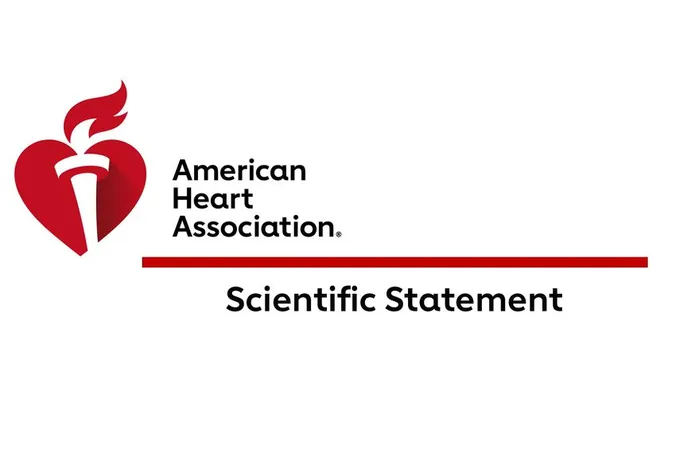
Urgent Call for Early Detection and Aggressive Treatment in High-Risk Kawasaki Disease Patients
2024-11-13
Author: Yu
Introduction
In a groundbreaking new scientific statement from the American Heart Association (AHA), recent advancements have underscored the critical importance of early detection and tailored treatment strategies for high-risk patients suffering from Kawasaki Disease. This statement, published in the esteemed journal *Circulation*, reveals how improved diagnostic and imaging technologies are reshaping the landscape of care for this rare and serious illness, primarily affecting children.
Understanding Kawasaki Disease
Kawasaki Disease is recognized as the leading cause of acquired heart disease in children in the developed world. Despite its rarity, primarily affecting children under five, the urgency for awareness and early intervention cannot be overstated. Health professionals diagnose the condition based on a set of symptoms such as prolonged fever, rash, red eyes, and swelling in the extremities. Alarmingly, without prompt treatment, approximately 25% of affected children could face serious coronary complications, including coronary artery dilation and aneurysms.
Assessing Coronary Risks
To assess coronary risks, healthcare providers utilize coronary artery Z-scores, which compare a child’s coronary artery sizes to a normative dataset based on age, sex, and body size. Children exhibiting Z-scores above 2.5 are flagged for increased risk of developing life-threatening aneurysms. The statement emphasizes the necessity for consistent methodologies in measuring and tracking these scores over time, ensuring accurate risk classification.
New Risk Scoring System
Due to the challenge of early identification in diverse populations, clinicians in North America have proposed a new risk scoring system. This system integrates various risk factors, including age (especially under six months), ethnicity, Z-scores, and inflammatory markers like C-reactive protein. The goal is to promptly identify and direct high-risk patients towards more intensive treatment protocols that can significantly mitigate coronary artery complications.
Monitoring and Treatment Recommendations
Regular echocardiograms are now recommended, particularly for patients with elevated Z-scores, to monitor heart health and detect any abnormalities promptly. The refinement in echocardiographic techniques since the last statement in 2017 allows for better identification of dilation and aneurysms, crucial for preventing serious cardiovascular issues down the line.
Intravenous Immunoglobulin Treatment
Intravenous immunoglobulin (IVIG) remains the first line of defense against Kawasaki Disease, though recent studies suggest that adjusting doses based on a child’s lean body mass may lower the risk of complications, particularly in obese patients. Furthermore, ongoing trials are evaluating the effectiveness of low to medium doses of aspirin, which may perform just as well as higher doses during the disease's acute phase.
Emerging Therapies
New therapies, including corticosteroids and infliximab, show promise for high-risk children resistant to IVIG treatment, providing healthcare professionals with additional options to prevent serious coronary artery issues. For those with significant aneurysms, a combination of aspirin and anticoagulants like warfarin might be necessary to stave off dangerous clotting, with newer direct oral anticoagulants emerging as possibly safer alternatives pending further research.
Impact of COVID-19 on Diagnosis
Additionally, the COVID-19 pandemic revealed an uptick in Multisystem Inflammatory Syndrome in Children (MIS-C), which shares symptoms with Kawasaki Disease. Differentiating between the two has become vital, with new research pinpointing additional MIS-C symptoms like gastrointestinal issues, which do not typically appear in Kawasaki Disease. Machine learning algorithms are also being explored as tools to improve diagnostic accuracy.
Multidisciplinary Management
The statement further emphasizes the importance of multidisciplinary approaches in managing Kawasaki Disease, especially in cases complicated by giant aneurysms, which necessitate comprehensive, long-term treatment plans to mitigate risks of further cardiovascular events.
Care for Young Adults
Moreover, young adults with a history of Kawasaki Disease may be vulnerable during pregnancy, requiring specialized care from both obstetricians and cardiologists familiar with their medical backgrounds.
Conclusion
This updated statement not only serves as a vital resource for medical professionals but also highlights an urgent call to action for ongoing research and informed public awareness around Kawasaki Disease. With the right approach, we can significantly improve outcomes for children and young adults affected by this complex condition.


 Brasil (PT)
Brasil (PT)
 Canada (EN)
Canada (EN)
 Chile (ES)
Chile (ES)
 España (ES)
España (ES)
 France (FR)
France (FR)
 Hong Kong (EN)
Hong Kong (EN)
 Italia (IT)
Italia (IT)
 日本 (JA)
日本 (JA)
 Magyarország (HU)
Magyarország (HU)
 Norge (NO)
Norge (NO)
 Polska (PL)
Polska (PL)
 Schweiz (DE)
Schweiz (DE)
 Singapore (EN)
Singapore (EN)
 Sverige (SV)
Sverige (SV)
 Suomi (FI)
Suomi (FI)
 Türkiye (TR)
Türkiye (TR)